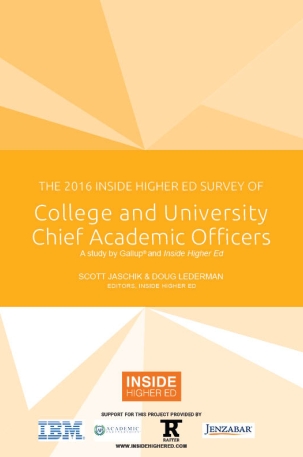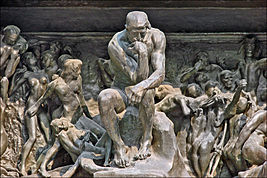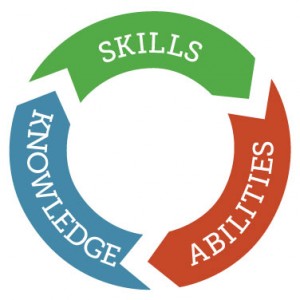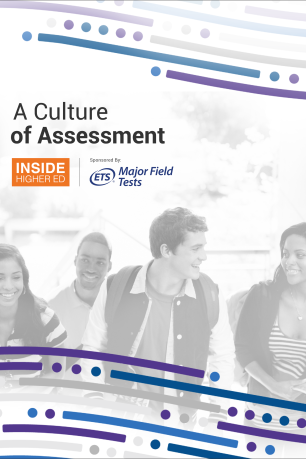Free Download

At a time of intense pressure on academic leaders, provosts are worried about the future of liberal arts education -- not just at liberal arts colleges, but at all institutions that provide general education to students.
They have real doubts about their budget situations, some new MOOC-inspired forms of higher education and the ability to preserve academic integrity when pursuing big-time athletics.
But amid these and other problems, the provosts generally feel good about the academic health of their institutions. And the provosts are generally becoming more open to competency-based education (a form of higher education of which many academics were skeptical just a few years ago). On trigger warnings, one of the hotly debated issues in academe in the last year, the provosts are divided (but leaning toward dubious).
On tenure -- of keen interest to many faculty members -- the provosts aren't pushing for change, but are quite open to long-term contracts as an alternative.
About the Survey
Inside Higher Ed's 2016 Survey of Chief Academic Officers was conducted in conjunction with Gallup. A copy of the report can be downloaded here.
Inside Higher Ed regularly surveys key higher ed professionals on a range of topics.
On Feb. 16, Inside Higher Ed Editors Scott Jaschik and Doug Lederman shared and analyzed the findings and answered readers' questions in a webinar. View the webinar.
The Inside Higher Ed survey of provosts was made possible in part by advertising from IBM, Academic Partnerships, Rafter and Jenzabar.
These are some of the findings of the 2016 Inside Higher Ed Survey of College and University Chief Academic Officers, conducted by Gallup and answered by 539 provosts or chief academic officers. The academic leaders received complete anonymity on their responses, but their answers were coded by institution to allow for analysis by sector in some cases. You can download the full survey questions and responses here.
An Uncertain Future for the Liberal Arts
The provosts responded to questions about the liberal arts at a time of considerable angst at many liberal arts colleges and in the liberal arts divisions of many colleges and universities that also have professional degree programs. Some liberal arts colleges report unsustainable finances and difficulty attracting enough applicants. Liberal arts departments seem to be targets for elimination at all kinds of institutions. Parents and politicians worry (even if evidence doesn't neatly back up the concern) that today's liberal arts major is tomorrow's nonpaying tenant in her parents' basement.
The good news for supporters of the liberal arts is that provosts are in their corner. Two-thirds of provosts nationally strongly agree that liberal arts education "is central to undergraduate education, even in professional programs." Another 26 percent agree, just not strongly.
For purposes of this survey, Inside Higher Ed asked academic leaders to identify whether they worked at a liberal arts institution and 46 percent said yes. Not surprisingly, those who identified themselves as working at liberal arts institutions were more likely than other provosts to answer yes to the question in the previous paragraph about the centrality of liberal arts, with 95 percent strongly agreeing or agreeing. But a substantial majority of provosts at non-liberal arts institutions (89 percent) also agreed or strongly agreed.
 The provosts' appreciation for the liberal arts does not give them rose-colored glasses about the current challenges facing liberal arts institutions, though.
The provosts' appreciation for the liberal arts does not give them rose-colored glasses about the current challenges facing liberal arts institutions, though.
In answers to a series of questions about the future of the liberal arts, chief academic officers at liberal arts institutions said they feel pressure against the liberal arts, and see the hostility -- just perhaps not as much as those at non-liberal arts institutions. For instance, just under 40 percent of provosts at liberal arts institutions said they feel pressure from presidents, boards or donors to focus on academic programs that have an orientation toward careers.
And half of provosts of liberal arts institutions (and 60 percent of provosts at other institutions) expect the number of liberal arts colleges "to decline significantly over the next five years."
Provosts Respond to Statements on Future of Liberal Arts
| Statement | % of Liberal Arts Provosts Agreeing | % of Non-Liberal Arts Provosts Agreeing |
| Politicians, presidents and boards are increasingly unsympathetic to liberal arts education. | 68% | 62% |
| I feel pressure from my president, board or donors to focus on academic programs that have a clear orientation toward careers. | 39% | 61% |
| Liberal arts education at all types of institutions in the U.S. is in decline | 44% | 52% |
| I expect to see the number of liberal arts colleges decline significantly over the next five years. | 50% | 60% |
While the provosts are in many ways pessimistic about the role of liberal arts in higher education in the years ahead, they aren't embracing some of the common critiques leveled at liberal arts education by politicians and pundits.
For instance, only 27 percent of liberal arts college academic officers and 38 percent of non-liberal arts college provosts agreed or strongly agreed with the statement "Liberal arts education has become too divorced from the career needs of students and graduates." And only 33 percent of provosts at both sets of institutions agreed or strongly agreed with the statement "Liberal arts faculty are not sufficiently interested in the desire of parents and students for career preparation."
Alternatives to Tenure
In seeing a decline in the liberal arts ahead, the provosts may well be reading the tea leaves about the views of many presidents. A panel of the Council of Independent Colleges, an organization of small and medium-size private colleges, many of them historically liberal arts colleges, recently drafted a list of essential and negotiable characteristics of small private colleges. Among the items that ended up on the negotiable list: "the definition and centrality of 'liberal arts.'" Also on the negotiable list was tenure.
On this issue, too, the provosts in the new survey appear flexible -- if not looking to push change.
Two-thirds of chief academic officers -- 67 percent -- agreed or strongly agreed that "tenure remains important and viable at my institution." The level of agreement was lowest at community colleges (many of which don't have tenure). But even there a majority of provosts (52 percent) agreed.
But when asked if they would favor "a system of long-term contracts over the existing tenure system in higher education," 61 percent of provosts answered in the affirmative.
Tight Times Financially
Nationally there is much talk of an improving economy, but provosts (who of course must work to balance academic budgets) aren't feeling it. This is especially the case in public higher education, where higher education spending by states has increased, but generally has not brought college coffers back to where they were prior to the economic downturn of 2008.
While 48 percent of private college academic officers agreed that their institution's financial situation has improved in the last year, that was true only for 32 percent of provosts at public institutions. And while 39 percent of provosts at private institutions agreed that the economic downturn "is effectively over" at their college or university, only 22 percent of those at public institutions agreed.
 So how are provosts viewing their future finances? Majorities of those at public and private institutions (greater at publics) said new funds for academic programs will come by reallocating existing resources, not in the form of totally new funds. At a minority of institutions (29 percent of publics and 20 percent of privates), provosts said they needed to eliminate more academic programs. And when colleges and universities consider whether to add new academic programs, financial concerns are a major factor at both public (90 percent) and private (89 percent) institutions, the academic officers reported.
So how are provosts viewing their future finances? Majorities of those at public and private institutions (greater at publics) said new funds for academic programs will come by reallocating existing resources, not in the form of totally new funds. At a minority of institutions (29 percent of publics and 20 percent of privates), provosts said they needed to eliminate more academic programs. And when colleges and universities consider whether to add new academic programs, financial concerns are a major factor at both public (90 percent) and private (89 percent) institutions, the academic officers reported.
In terms of thinking of strategies to add revenue, online education dominates, with 82 percent of public college provosts and 76 percent of private college academic officers saying that in the next year they plan to increase emphasis on starting online programs.
Trigger Warnings
One of the hot issues involving teaching in the last year has been trigger warnings. In an informal sense, faculty members may use them all the time, mentioning in passing that students are about to read or view, for example, something that is violent. But some have argued that there should be formal warnings placed on course syllabi so that those who might experience trauma because of a scene or image that is racist or sexist or homophobic might prepare themselves or (some argue) be excused from doing that particular reading.
To some, trigger warnings are a common-sense courtesy and a way to be inclusive of students from a variety of backgrounds. Others see trigger warnings as an example of what they call coddling of students.
Many provosts are skeptical of the trend. (And while many conservative critics have suggested that trigger warnings are widespread, the skepticism of provosts actually appears to be matched by that of many professors.)
Only 12 percent of provosts agreed or strongly agreed that professors should be required to use trigger warnings in some cases. But stepping away from requirements, 35 percent agreed or strongly agreed that trigger warnings "are a useful tool for faculty members to use." There wasn't much variation by sector, although there was slightly more support for that idea among private baccalaureate institutions.
 Only 35 percent of provosts were open to the idea of making exceptions to assignments for some students, providing them with "alternative assignments, with no consequence for their grade, if they express concern about completing an assigned work in response to a trigger warning." In this answer, there was a significant gap by sector, with 45 percent of chief academic officers at private baccalaureate institutions agreeing.
Only 35 percent of provosts were open to the idea of making exceptions to assignments for some students, providing them with "alternative assignments, with no consequence for their grade, if they express concern about completing an assigned work in response to a trigger warning." In this answer, there was a significant gap by sector, with 45 percent of chief academic officers at private baccalaureate institutions agreeing.
Responses to other questions, however, suggest that many provosts worry about trigger warnings:
- 72 percent of provosts said that they believed trigger warnings "may discourage students from encountering important works of literature or art."
- 58 percent of provosts said that they believed trigger warnings "are part of a trend of colleges going too far to protect students from things that may make them uncomfortable."
Academic Integrity in Big-Time Athletic Programs
Provosts are in theory the senior academic officials on campus. Even if most don't supervise athletics, they are among those charged with making sure that athletes -- even those playing at the most competitive levels -- are in fact getting an education. In the last year, several prominent sports programs have been found to have violated rules about academics, raising anew questions about whether academic values are compromised by big-time athletics.
 On this issue, the provosts repeated a pattern seen in other Inside Higher Ed surveys of senior administrators: they believe a problem is widespread, but not at their institutions.
On this issue, the provosts repeated a pattern seen in other Inside Higher Ed surveys of senior administrators: they believe a problem is widespread, but not at their institutions.
Asked if academic fraud was widespread at colleges and universities with big-time athletic programs, 61 percent of provosts agreed or strongly agreed.
Then asked if they "felt confident in the academic integrity" of athletics programs at their institutions, 84 percent said they did. For those wondering if the numbers were boosted by the many colleges that do not participate in big-time athletics, the confidence levels were highest at doctoral institutions, a sector with many big-time programs.
Competency-Based Education: The Public/Private Split
Inside Higher Ed has been asking provosts for several years now about competency-based education, in which credits and degrees are awarded not based on completion of formal courses, but on demonstration by students that they have certain skills or competencies. In competency-based education, students can theoretically earn degrees much more speedily than would be possible in traditional degree programs. Many politicians and pundits love the idea.
Based on the new poll, more than half of colleges now award some credit based on competency. The question was phrased in a way that a college that only does so with one program or area would have answered yes -- and the effort need not be a full-fledged degree. So an affirmative answer does not mean that a college has a full-fledged competency arm, like that of Southern New Hampshire University, or is a competency-based university like Western Governors University.
But based on Inside Higher Ed's low threshold, a majority of colleges and universities (54 percent) are now awarding some competency-based credit. That's up from 44 percent just a year ago.
That's a notable gain, but public institutions are far more likely than private institutions to be answering yes. Among publics, the figure is 69 percent, up from 55 percent a year ago. Among private institutions, the figure is 38 percent, up from 34 percent a year ago.
The answers to other questions suggest the private-public gap is likely to grow. The chief academic officers at colleges that do not currently offer any competency-based programs were asked if it was likely that their institutions would start them in the future. At public institutions, 35 percent of provosts said that was likely. At private institutions, the figure was only 6 percent.
The public-private divide was also evident in the reactions of provosts to other questions about competency-based education.
 Seventy percent of provosts at public institutions said that "it should be easier for students to earn credits and degrees based on what they have learned, not just time in the classroom." In contrast, 49 percent of private college provosts shared that view.
Seventy percent of provosts at public institutions said that "it should be easier for students to earn credits and degrees based on what they have learned, not just time in the classroom." In contrast, 49 percent of private college provosts shared that view.
General education has also been a major concern of skeptics of competency-based education, who fear that the focus on the specific competencies associated with a degree or certificate may be easier to measure than the more general writing, critical-thinking and other skills associated with general education.
On this issue, 26 percent of public college provosts and 45 percent of private college provosts agree that competency-based education can be "damaging to general education." In the last two years, those figures have dropped from 39 percent (publics) and 50 percent (privates).
Not Inspired by MOOC-Inspired Programs
In past surveys, provosts were not terribly impressed by massive open online courses. Of late, however, some MOOC-inspired approaches that aren't quite MOOCs have been receiving a lot of attention in the public. While the programs vary, they involve MOOCs to deliver material that could make up part of an eventual degree. Consider this program from Arizona State University, or one from the Massachusetts Institute of Technology.
 Asked if these new MOOC-inspired programs would provide "high-quality education to students," the provosts were dubious. Only 12 percent thought so.
Asked if these new MOOC-inspired programs would provide "high-quality education to students," the provosts were dubious. Only 12 percent thought so.
But just because they might not be high quality doesn't mean these programs might not be a threat to other institutions, in the provosts' view. Asked to respond to the statement "If these programs succeed, they will represent serious competition to many existing programs at other colleges," 47 percent agreed and 29 percent disagreed.
On many issues over the years involving MOOCs and online education, provosts have been strong advocates for using accreditation to ensure quality in new kinds of course and program delivery. It's the same here. Seventy-three percent of provosts agree or strongly agree that accreditors should conduct separate reviews of these programs and not just rely on the general institutional accreditation that the sponsoring colleges and universities have.
How Are Colleges Doing Over All?
Amid all the challenges reflected by the questions noted above, Inside Higher Ed also asked questions about what the provosts think about the overall academic health and effectiveness of their institutions (the latter question pegged to undergraduate education).
As has been the case, the provosts generally think their institutions are academically healthy and effective, but the private college provosts are more confident than the public ones -- with a notable exception (college costs). The most self-critical sector appears to be community colleges. (On the table below, they are part of the total for publics as well, but are included separately to highlight their views.) Not a single provost said his or her institution was in failing academic health.
Provosts Assess Academic Health of Their Institutions
| Private | Public (All) | Community Colleges | |
| Excellent | 33% | 27% | 22% |
| Good | 52% | 57% | 57% |
| Fair | 14% | 15% | 20% |
| Poor | 1% | 1% | 2% |
| Failing | 0% | 0% | 0% |
When it comes to effectiveness, the provosts give themselves strong marks on the total undergraduate experience, but lower marks in some specifics. Notably, despite much skepticism from politicians and parents about whether colleges are doing enough to prepare students for the world of work, provosts generally think their institutions are doing well. Also, while various questions in the survey show that nearly all colleges are doing multiple things in terms of assessment, and collecting lots of data, the provosts are less confident in their effectiveness at assessing students or using data.
Similar to the results on the question of academic health, not a single provost found his or her institution "not effective at all" in providing undergraduate education.
Provosts Assess Their Institutional Effectiveness
| Private | Public (All) | Community Colleges | |
| Providing a quality undergraduate education | |||
| -- Very effective | 74% | 61% | 55% |
| -- Somewhat effective | 26% | 38% | 44% |
| -- Not too effective | 1% | 1% | 1% |
| -- Not effective at all | 0% | 0% | 0% |
| Preparing students for the world of work | |||
| -- Very effective | 53% | 50% | 51% |
| -- Somewhat effective | 45% | 49% | 48% |
| -- Not too effective | 2% | 1% | 1% |
| -- Not effective at all | 0% | 0% | 0% |
| Offering undergraduate student support services | |||
| -- Very effective | 51% | 45% | 42% |
| -- Somewhat effective | 46% | 49% | 49% |
| -- Not too effective | 2% | 5% | 8% |
| -- Not effective at all | 0% | 1% | 1% |
| Recruiting and retaining qualified faculty members | |||
| -- Very effective | 39% | 29% | 26% |
| -- Somewhat effective | 55% | 56% | 56% |
| -- Not too effective | 5% | 14% | 17% |
| -- Not effective at all | 0% | 1% | 1% |
| Controlling rising costs for students and families | |||
| -- Very effective | 22% | 41% | 45% |
| -- Somewhat effective | 60% | 45% | 35% |
| -- Not too effective | 17% | 13% | 19% |
| -- Not effective at all | 1% | 0% | 1% |
| Preparing students for engaged citizenship | |||
| -- Very effective | 42% | 20% | 10% |
| -- Somewhat effective | 53% | 61% | 65% |
| -- Not too effective | 5% | 18% | 25% |
| -- Not effective at all | 0% | 1% | 1% |
| Identifying and assessing student outcomes | |||
| -- Very effective | 28% | 21% | 21% |
| -- Somewhat effective | 62% | 66% | 65% |
| -- Not too effective | 9% | 13% | 14% |
| -- Not effective at all | 1% | 0% | 0% |
| Using data to inform campus decision making | |||
| -- Very effective | 25% | 25% | 21% |
| -- Somewhat effective | 57% | 62% | 61% |
| -- Not too effective | 14% | 12% | 15% |
| -- Not effective at all | 4% | 2% | 3% |







